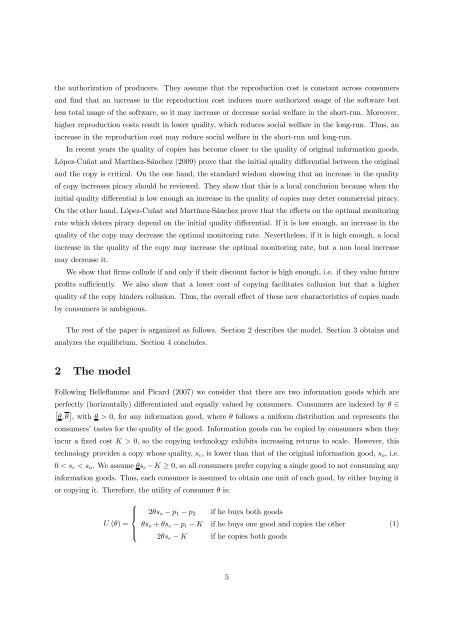You also want an ePaper? Increase the reach of your titles
YUMPU automatically turns print PDFs into web optimized ePapers that Google loves.
the authorization of producers. They assume that the reproduction cost is constant across consumers<br />
<strong>and</strong> find that an increase in the reproduction cost induces more authorized usage of the software but<br />
less total usage of the software, so it may increase or decrease social welfare in the short-run. Moreover,<br />
higher reproduction costs result in lower quality, which reduces social welfare in the long-run. Thus, an<br />
increase in the reproduction cost may reduce social welfare in the short-run <strong>and</strong> long-run.<br />
In recent years the quality of copies has become closer to the quality of original information goods.<br />
López-Cuñat <strong>and</strong> Martínez-Sánchez (2009) prove that the initial quality differential between the original<br />
<strong>and</strong> the copy is critical. On the one h<strong>and</strong>, the st<strong>and</strong>ard wisdom showing that an increase in the quality<br />
of copy increases <strong>piracy</strong> should be reviewed. They show that this is a local conclusion because when the<br />
initial quality differential is low enough an increase in the quality of copies may deter commercial <strong>piracy</strong>.<br />
On the other h<strong>and</strong>, López-Cuñat <strong>and</strong> Martínez-Sánchez prove that the effects on the optimal monitoring<br />
rate which deters <strong>piracy</strong> depend on the initial quality differential. If it is low enough, an increase in the<br />
quality of the copy may decrease the optimal monitoring rate. Nevertheless, if it is high enough, a local<br />
increase in the quality of the copy may increase the optimal monitoring rate, but a non local increase<br />
may decrease it.<br />
We show that firms collude if <strong>and</strong> only if their discount factor is high enough, i.e. if they value future<br />
profits sufficiently. We also show that a lower cost of copying facilitates collusion but that a higher<br />
quality of the copy hinders collusion. Thus, the overall effect of these new characteristics of copies made<br />
by consumers is ambiguous.<br />
The rest of the paper is organized as follows. Section 2 describes the model. Section 3 obtains <strong>and</strong><br />
analyzes the equilibrium. Section 4 concludes.<br />
2 The model<br />
Following Belleflamme <strong>and</strong> Picard (2007) we consider that there are two information goods which are<br />
perfectly (horizontally) differentiated <strong>and</strong> equally valued by consumers. Consumers are indexed by θ ∈<br />
£ ¤<br />
θ, θ ,withθ > 0, for any information good, where θ follows a uniform distribution <strong>and</strong> represents the<br />
consumers’ tastes for the quality of the good. Information goods can be copied by consumers when they<br />
incur a fixed cost K>0, so the copying technology exhibits increasing returns to scale. However, this<br />
technology provides a copy whose quality, s c , is lower than that of the original information good, s o , i.e.<br />
0

















